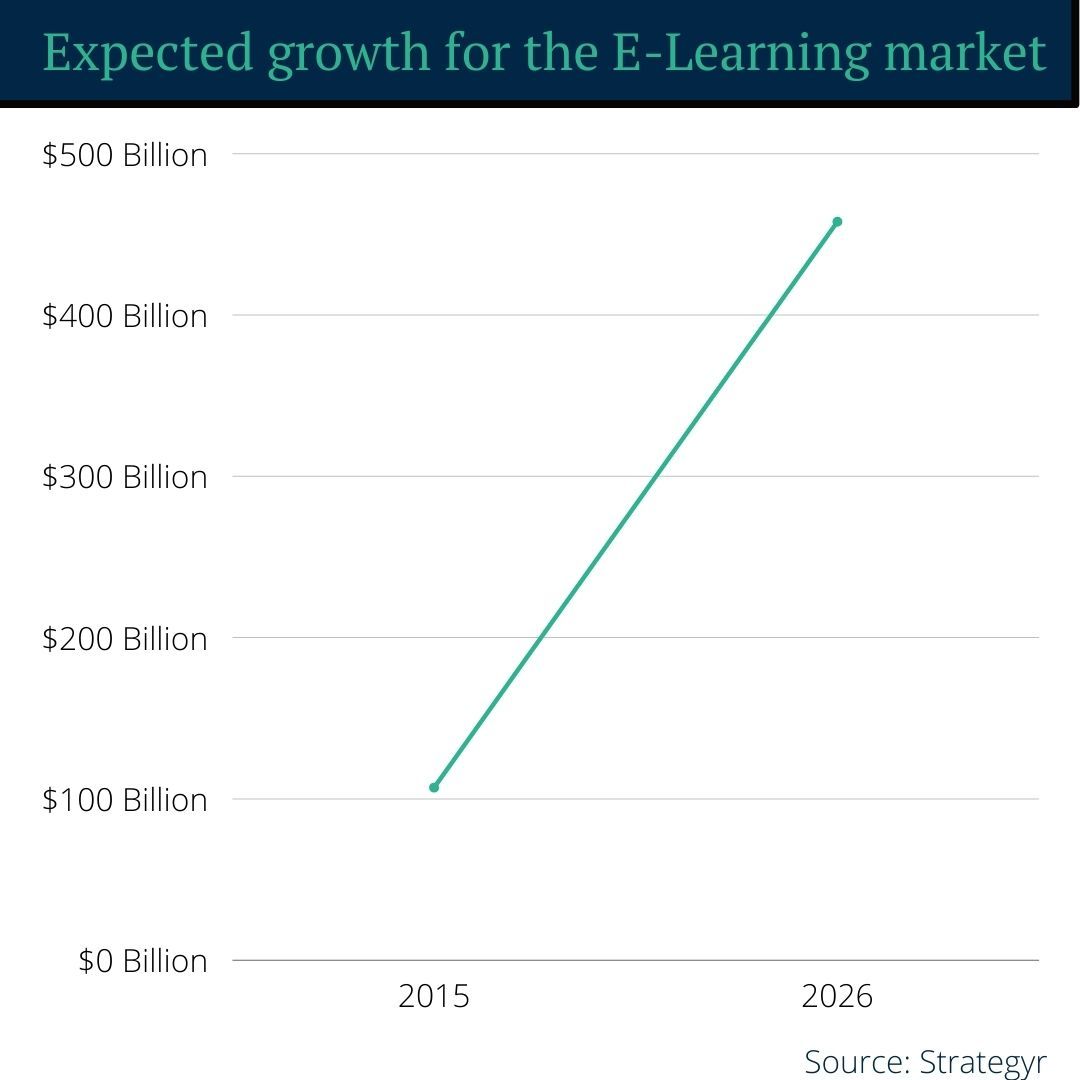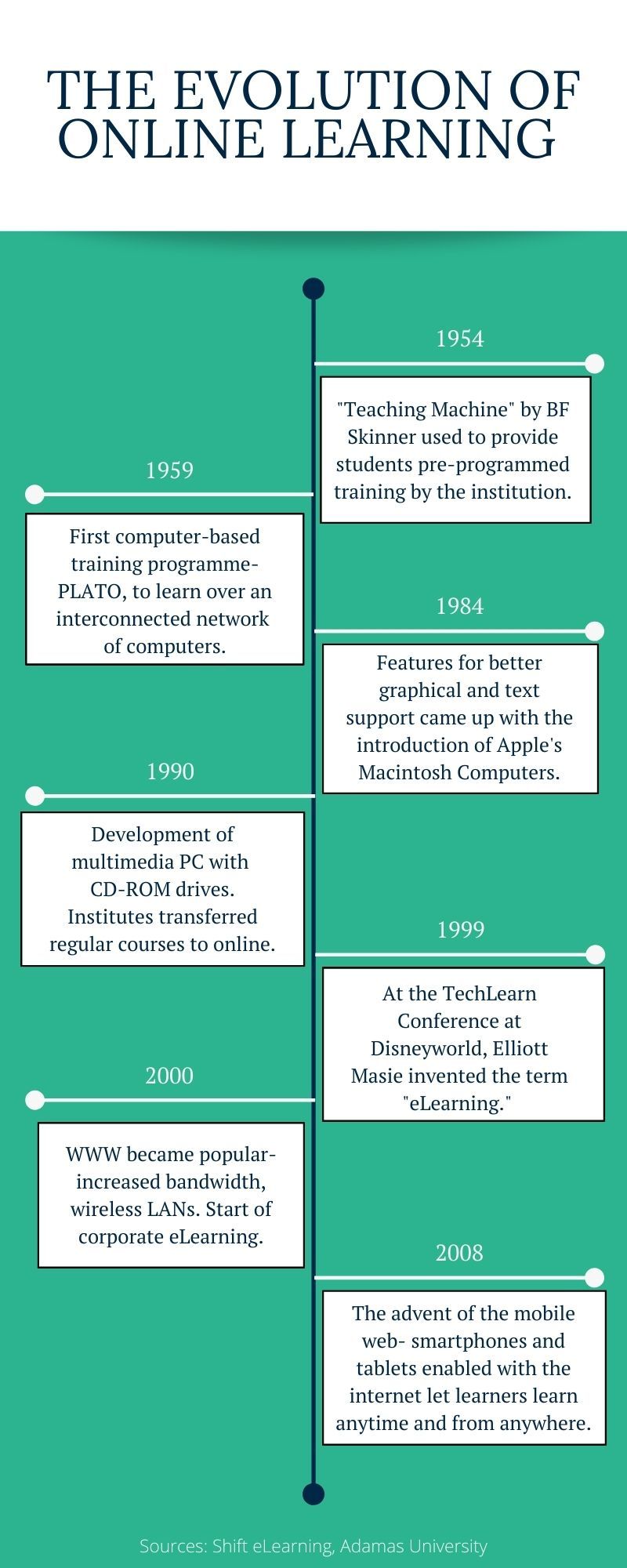How Did The Evolution Of Online Learning Change Education?

Since the turn of the decade, online learning or e-learning has virtually become a buzzword. Global Google searches for online courses increased by about 100% from mid-March to mid-April 2020 and the e-learning market is expected to rise at a breakneck pace of 10.3 percent CAGR from $107 billion in 2015 to $457.8 billion by 2026. This growing digitalization of education is transforming the way knowledge is consumed and delivered.
Students studying within the confines of their classrooms are soon becoming a thing of the past, as rapid technology breakthroughs and the widespread availability of internet access, even in rural regions, have altered the way students learn today. From using mobile devices to submit assignments to attending live lectures through laptops from anywhere, students are quickly evolving their learning styles. This shift can be attributed to the numerous advantages of online learning, such as lower costs, greater accessibility, the ability to choose when and where to learn, the availability of a wide range of course options, and so on, all of which have picked up steam as a result of the Covid-19 pandemic.

Although online learning existed prior to the Covid-19 pandemic and has been continuously expanding at a rate of 900 percent since 2000, its exponential development and popularity occurred only after the pandemic. So, let's take a look at how online learning has progressed over time and continues to do so as technology advances, offering up new possibilities in the education sector.
Online learning before the COVID-19 pandemic
Online learning as we know now has taken years of innovation and technological advancements. It was not always as interactive or multi-sensory as it is now. Earlier versions were devoid of adequate tools for instructors to create content and deliver it to their students. Interactions were also limited and making content available on multiple browsers was challenging. Amidst these challenges, online learning continued to rise due to its greater accessibility and scalability opportunities for organisations and institutions.
- It was in the 1960s, that the University of Illinois in the United States, launched the first computer-based training programme known as the PLATO-Programmed Logic for Automated Teaching Operations wherein, students learned over a network of interconnected computer terminals.
- The real push came with the introduction of Apple’s Macintosh Computers in 1984 which allowed for better graphical and text support. This encouraged teachers to create their own tutorials and software for their students giving rise to interactive eLearning. This was successful as this time students could keep computers at home and access course material online, easily.
- In the 2000s, when the World Wide Web became popular a plethora of sophisticated technologies was introduced. Organizations began training their employees online through skill development courses to expand their industry knowledge base and skillsets, especially with the arrival of increased bandwidth and high-speed internet.
- This rising penetration of the internet and mobile phones constantly drove the popularity of online learning as it became more and more accessible. According to this KPMG report, the e-learning business has grown by 900% since 2000.
- Universities like Duke and Cornell were already giving online certifications to students in the 1990s. and in the US by the year 2010, the number of students studying online had reached 3 million.

However, some drawbacks still existed with eLearning, like the disconnection of the instructors from their learners during the process of content creation and content delivery and the lack of real-time engagement. In order for the instructors to adapt their content into online frameworks, the content production process for online mode would always require a technological professional in the middle. For the instructors, this would result in a disconnect from the end product and their personal teaching style. Instructors would often struggle with online teaching owing to the technical requirements, and students would be forced to adjust to the lack of personalization in the content being taught.
There was an increasing demand for innovation to enable instructors to use their creative abilities freely, to take chances, to experiment, and to master new skills in order to generate content that met the needs of their students without sacrificing or getting alienated from their teaching style.
Online learning after the COVID-19 pandemic
In these trying times of the pandemic, learners and instructors were rapidly moving towards virtual modes of classrooms and online learning with the help of technology. Institutions and instructors who were previously reticent to integrate technological advancements into their daily classroom experience have been compelled to adapt to online modalities in order to provide content and construct interactive lesson plans for their students. This trend is leading the academic eLearning market towards an estimated $457.8 billion by 2026 with a record CAGR of 10.2%.
Institutions and instructors well adjusted to their traditional mode of face to face classroom teaching heavily relied on synchronous teaching or live classes with the help of platforms like Zoom, Google Classroom and others. However, this shift wasn’t easy as with inadequate IT infrastructure instructors were faced with the task of swiftly converting their offline course content to online without any prior training or experience.
Governments, organisations, and institutions all over the world increased their online platforms and edtech investments to help with the abrupt transition from physical to online classrooms:
- A whopping 10 million enrolments were recorded by the Government of India’s online learning platform- Swayam in less than a year. 149 universities, central and state-run in India, are now accepting credits earned by students through Swayam. This resulted in an increase in the number of online exam takers on Swayam from 70,000 in 2018 to 200,000 in 2020, whereas, the number of courses offered online has doubled since 2017.
- In China, more than 250 million students resumed their classes online full-time and Tencent added 100,000 new servers in eight days to accommodate their two-month-old product- Tencent conference, to meet the sudden surge of students relying on online learning.
- According to the findings by The College Crisis Initiative by Davidson college, 44% of educational institutions in the United States have fully adapted to online learning tools and platforms with online teaching as the primary mode of imparting education.
- Active meeting participants using Zoom- video conferencing application soared to a whopping 200 million in March 2020 from their previous record of only 10 million.
Although the pandemic led to an exponential increase in eLearning with the help of advancing technology, there were challenges with regard to lack of focus, inadequate engagement, lack of structure or know-how for online platforms which culminated into a very stressful experience for both the instructors and the learners. While instructors were grappling with methods and adequate time to deliver quality education to their learners, the learners felt disconnected due to the lack of in and after-class interactions with their instructors.
It is critical we redefine online learning—exploring the different online alternatives by embracing technology—to support instructors in generating and delivering high-quality content that is appropriate for their teaching styles, as well as for learners to receive holistic learning. Instructors can now use digital resources such as social media platforms, MOOCs, and technology such as learning software and teaching assistant chatbots to streamline various other classroom activities.
The future of online learning
Online learning appears to be rising exponentially with more and more universities opting for online learning, particularly in light of the Covid-19 pandemic. As the education sector was thrown into disarray with the growing demand for remote learning, new innovations in technology have become the need of the hour.

As a result of this demand, the sector has seen the development of artificially intelligent chatbots that can automate and streamline the teaching and learning process. It is going to be a real game-changer for remote learning.
- With the sudden growth in online learning, AI chatbots can help instructors with the delivery of user-centric content leading to greater personalisation for learners.
- It can quickly cater to the queries of the learners as well as their guardians, thus acting as an assistant to the instructors easing their workload as well as saving a lot of time.
- It can also work towards building a more interactive, collaborative online class wherein the learners can get in-class doubts solved without disturbing an ongoing class.
- Chatbots can also cater to a learner’s need for instant information regarding technical support, admission process, learning outcomes, upcoming assignments, exams, curriculum and much more thereby unburdening instructors allowing them to focus on providing quality education instead of logistical support.
- The instructors can receive feedback and keep track of their learner’s progress by means of FAQ chat interfaces.
The sudden transition to online led instructors as well as learners to grapple with adopting new methods in education overnight, not having enough time for training or creating a structure for content creation, delivery and consumption. Instructors have been extensively burdened with logistical work in addition to providing classes to learners. In these situations when mitigating such challenges is necessary AI chatbots have come to the rescue for the education sector catapulting it towards a new era of development.
